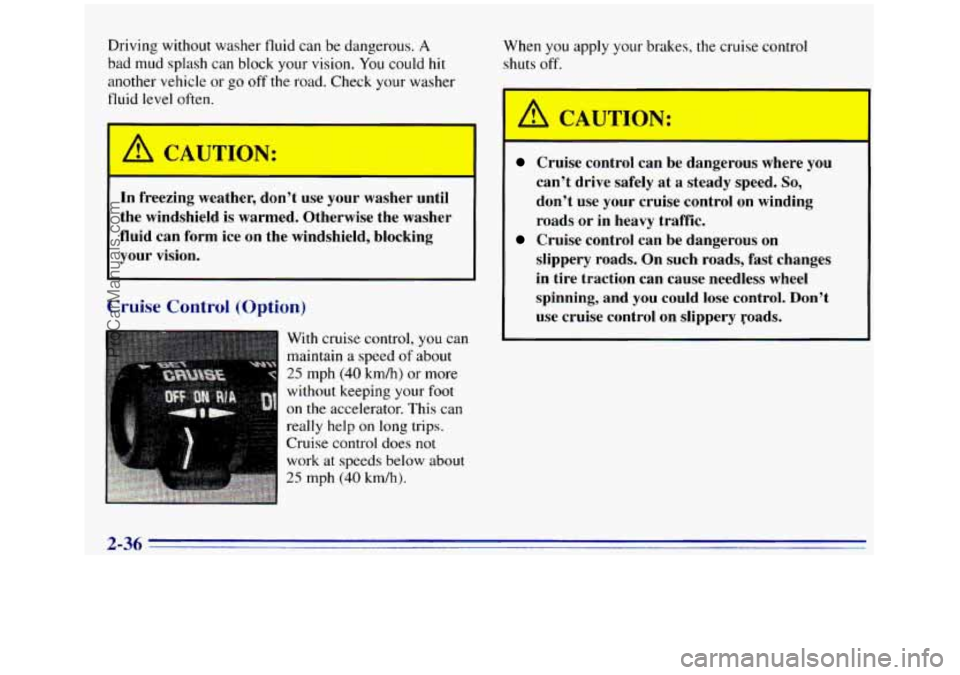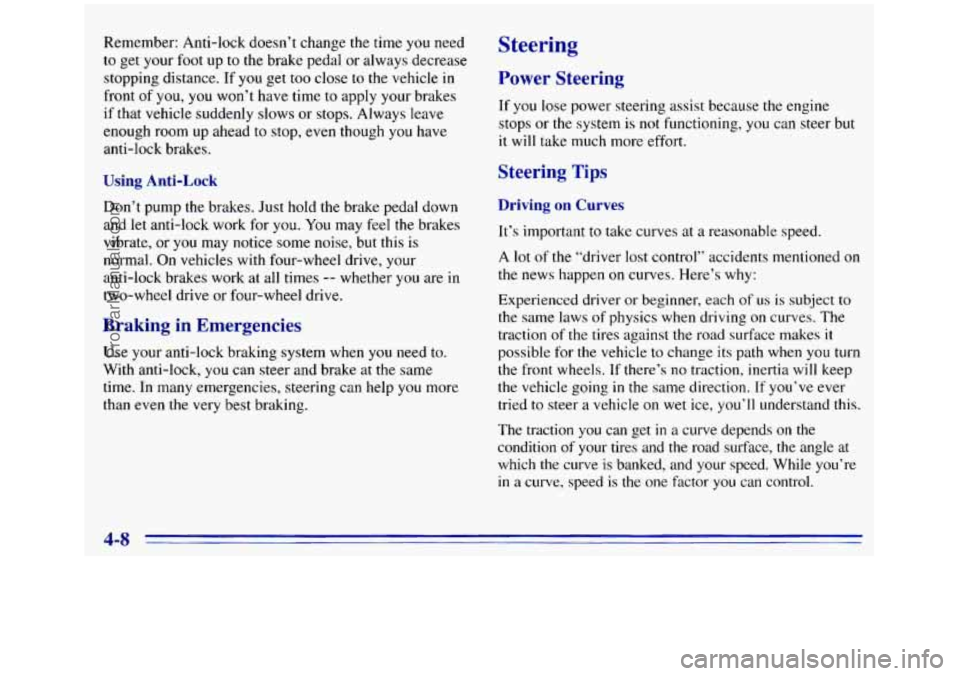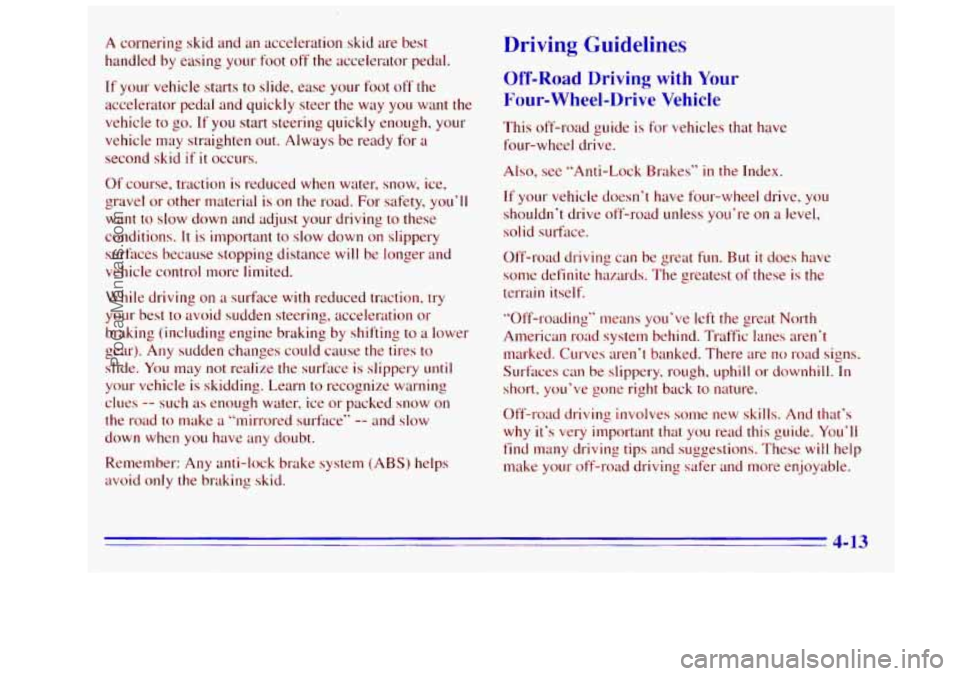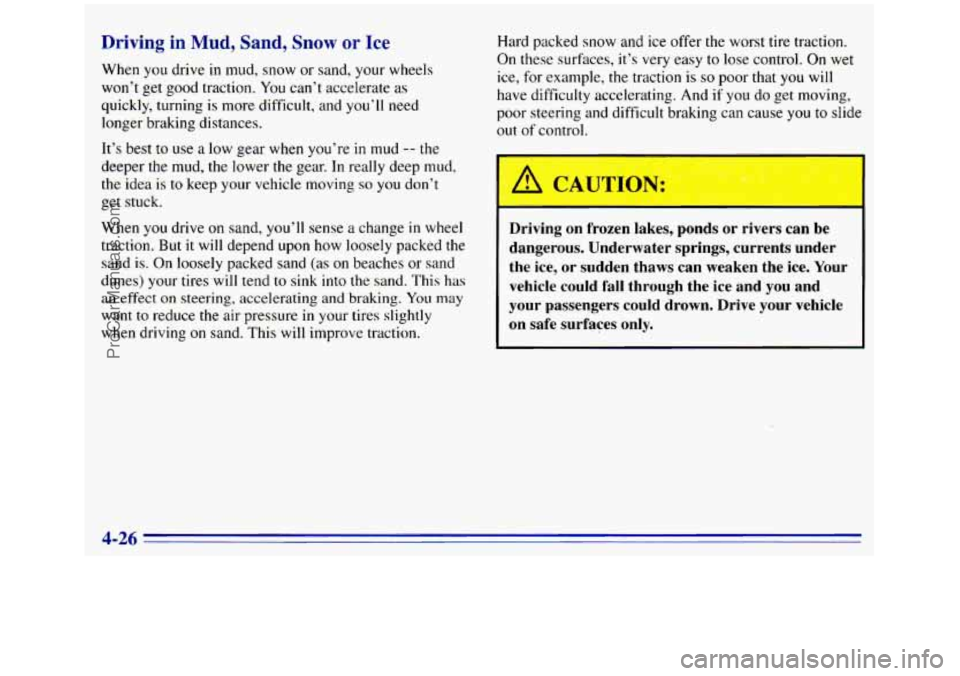1996 GMC SIERRA traction control
[x] Cancel search: traction controlPage 98 of 404

Driving without washer fluid can be dangerous. A
bad mud splash can block your vision. You could hit
another vehicle or go off the road. Check your washer
fluid
level often.
A CAUTION:
In freezing weather, don't use your washer until
the windshield is warmed. Otherwise the washer
fluid can form ice on the windshield, blocking
your vision.
Cruise Control (Option)
With cruise control, y6u Cgn
maintain a speed of about
25 mph (40 kdh) or more
without keeping your
foot
on the accelerator. This can
really help on
long trips.
Cruise control does not
work at speeds below about
25 mph (40 km/h).
When you apply your brakes, the cruise control
shuts off.
Cruise control can be dangerous where you
can't drive safely at
a steady speed. So,
don't use your cruise control on winding
roads
or in heavy traffic.
slippery roads. On such roads, fast changes
in tire traction can cause needless wheel
spinning, and you
could lose control. Don't
use cruise control on slippery yoads.
Cruise control can be dangerous on
2-36
.
ProCarManuals.com
Page 162 of 404

Remember: Anti-lock doesn’t change the time you need
to get your foot up to the brake pedal or always decrease
stopping distance. If
you get too close to the vehicle in
front of you, you won’t have time to apply your brakes
if that vehicle suddenly slows or stops. Always leave
enough room up ahead to stop, even though you have
anti-lock brakes.
Using Anti-Lock
Don’t pump the brakes. Just hold the brake pedal down
and
let anti-lock work for you. You may feel the brakes
vibrate, or you may notice some noise, but this
is
normal. On vehicles with four-wheel drive, your
anti-lock brakes work at all times
-- whether you are in
two-wheel drive
or four-wheel drive.
Braking in Emergencies
Use your anti-lock braking system when you need to.
With anti-lock, you can steer and brake at the same
time. In many emergencies, steering can help
you more
than even the very best braking.
Steering
Power Steering
If you lose power steering assist because the engine
stops or the system is not functioning, you can steer but
it will take much more effort.
Steering Tips
Driving on Curves
It’s important to take curves at a reasonable speed.
A lot of the “driver lost control” accidents mentioned on
the news happen on curves. Here’s why:
Experienced driver or beginner, each
of us is subject to
the same laws
of physics when driving on curves. The
traction
of the tires against the road surface makes it
possible for the vehicle to change its path when you turn
the front wheels. If there’s no traction, inertia will keep
the vehicle going
in the same direction. If you’ve ever
tried to steer a vehicle on wet ice, you’ll understand
this.
The traction you can get in a curve depends on the
condition of your tires and
the road surface, the angle at
which
the curve is banked, and your speed. While you’re
in a curve, speed is the one factor you can control.
4-8
ProCarManuals.com
Page 167 of 404

A cornering skid and an acceleration skid are best
handled by easing your
foot off the accelerator pedal.
If your vehicle starts to slide, ease your foot off the
accelerator pedal and quickly
steer the way you want the
vehicle to go. If you start steering quickly enough, your
vehicle may straighten out. Always be ready for
a
second skid if it occurs.
Of course, traction is reduced when water, snow, ice,
gravel or other material is on the road. For safety,
you’ll
want to slow down and adjust your driving to these
conditions. It is important to slow down on slippery
surfaces because stopping distance will be longer and
vehicle control more limited.
While driving
on a surface with reduced traction, try
your best to avoid sudden steering, acceleration or
braking (including engine braking by shifting
to a lower
gear).
Any sudden changes could cause the tires to
slide. You may not realize the surface is slippery until
your vehicle is skidding. Learn to recognize warning
clues
-- such as enough water, ice or packed snow on
the road
to make a “mirrored surface” -- and slow
down when you have any doubt.
Remember:
Any anti-lock brake system (ABS) helps
avoid
only the braking skid.
Driving Guidelines
Off-Road Driving with Your
Four-Wheel-Drive Vehicle
This off-road guide is for vehicles that have
four-wheel drive.
Also, see “Anti-Lock Brakes” in the Index.
If your vehicle doesn’t have four-wheel drive, you
shouldn’t drive off-road unless you’re on a level,
solid surface.
Off-road driving can be great
fun. But it does have
some definite hazards.
The greatest of these is the
terrain itself.
“Off-roading” means you’ve left
the great North
American road system behind. Traffic lanes aren’t
marked. Curves aren’t banked. There are
no road signs.
Surfxes can
be slippery, rough, uphill or downhill. In
short, you’ve gone right back to nature.
Off-road driving involves some new skills. And that’s
why it’s very important that
you read this guide. You’ll
find many driving tips and suggestions. These
will help
make your off-road driving safer and more enjoyable.
4-13
ProCarManuals.com
Page 170 of 404

Controlling your vehicle is the key to successful
off-road driving. One
of the best ways to control your
vehicle
is to control your speed. Here are some things to
keep in mind. At higher speeds:
you approach things faster and you have less time to
you have less time to react.
scm
the terrain
for obstacles.
you have more vehicle bounce when you drive
over obstacles.
you’ll need more distance for braking, especially
since you’re on an unpaved surface.
When you’re driving off-road, bouncing and
quick changes in direction can easily throw you
out of position. This could cause you to lose
control and crash.
So, whether you’re driving on
or off the road, you and your passengers should
wear safety belts.
Scanning the Terrain
Off-road driving can take you over many different
kinds of terrain.
You need to be familiar with the
terrain and its many different features. Here are some
things to consider.
Surface Conditions. Off-roading can take you over
hard-packed dirt, gravel, rocks, grass, sand, mud,
snow
or ice. Each of these surfxes affects the steering,
acceleration and braking
of your vehicle in different
ways. Depending upon the kind of surface
you are
on, you may experience slipping, sliding, wheel
spinning, delayed acceleration, poor traction and
longer braking distances.
Swfuce Obsrdes. Unseen or hidden obstacles can
be hazardous. A rock, log, hole, rut or bump can
startle you
if you’re not prepared for them. Often these
obstacles are hidden by grass, bushes, snow or even
the rise and fall
of the terrain itself. Here are some
things to consider:
Is the path ahead clear?
0 Will the surfxe texture change abruptly up ahead?
Does the travel take you uphill or downhill? (There’s
more discussion of these subjects later.)
0 Will you have to stop suddenly or change
direction quickly?
4-16
ProCarManuals.com
Page 180 of 404

Driving in Mud, Sand, Snow or Ice
When you drive in mud, snow or sand, your wheels
won’t get good traction.
You can’t accelerate as
quickly, turning
is more difficult, and you’ll need
longer braking distances.
It’s best to
use a low gear when you’re in mud -- the
deeper the mud, the lower the gear. In really deep mud,
the idea is to keep your vehicle moving so you don’t
get stuck.
When
you drive on sand, you’ll sense a change in wheel
traction. But
it will depend upon how loosely packed the
sand is. On loosely packed sand (as on beaches or sand
dunes) your tires will tend
to sink into the sand. This has
an effect on steering, accelerating and braking. You may
want t.o reduce the air pressure in your tires slightly
when driving
on sand. This will improve traction. Hard
packed snow and ice offer the worst tire traction.
On these surfaces, it’s very easy
to lose control. On wet
ice, for example, the traction is so poor that you will
have difficulty accelerating. And if you do get moving,
poor steering and difficult braking can cause
you to slide
out of control.
Driving on frozen lakes, ponds or rivers can be
dangerous. Underwater springs, currents under
the ice, or sudden thaws can weaken the ice. Your
vehicle could fall through the ice and you and
your passengers could drown. Drive your vehicle
on safe surfaces only.
4-26
ProCarManuals.com
Page 304 of 404

-
A CAUTION:
Mixing tires could cause you to lose control while
driving.
If you mix tires of different sizes or types
(radial and bias-belted tires), the vehicle may not
handle properly, and you could have a crash.
Using tires of different sizes may also cause
damage to your vehicle.
Be sure to use the same
size and type tires on all wheels.
Uniform Tire Quality Grading
The following information relates to the system
developed by the United States National Highway
Traffic Safety Administration, which grades tires
by
treadwear, traction and temperature performance.
(This applies only to vehicles sold in the United States.)
The grades are molded on the sidewalls of most
passenger car tires. The Uniform Tire Quality Grading
system does
not apply to deep tread, winter-type snow
tires, space-saver or temporary
use spare tires, tires with
nominal rim diameters
of IO to 12 inches (25 to 30 cm),
or to some limited-production tires. While
the tires available on General Motors passenger
cars and light trucks may vary with respect to these
grades,
they must also conform to Federal safety
requirements and additional General Motors Tire
Performance Criteria (TPC) standards.
Treadwear
The treadwear grade is a comparative rating based on
the wear rate of the tire when tested under controlled
conditions on
a specified government test course. For
example. a tire graded 150 would wear one and a half
(1 1/2) times as well on the government course as a tire
upon the actual conditions of their use, however, and
may depart significantly from
the norm due to variations
in driving habits, service practices and differences in
road characteristics and climate.
E at-aded 100. The relative performance of tires depends
Traction -- A, B, C
The traction grades, from highest to lowest, are A, B, and
C, and they represent
the tire’s ability to stop on wet
pavement as measured under controlled conditions on
specified government test surfaces
of asphalt and concrete.
A tire marked C may have poor traction performance.
Warning: The traction grade assigned
to this, tire is based
on braking (straightahead) traction tests and does not
include cornering (turning) traction.
6-54
ProCarManuals.com
Page 400 of 404

Tape Player Care ............................... 3-24
Temperature Control. Climate Control System
..... 3- I. 3-3
Theft
.......................................... 2-7
Theft-Deterrent Feature
.......................... 3-2 1
Thermostat .................................... 6-30
Third Door ..................................... 2-3
Tilt Steering Wheel
............................. 2-33
Time. Setting the
................................ 3-7
Tirechains
.................................... 6-57
Tire Loading
................................... 4-42
Tires
......................................... 6-48
Alignment and Balance
........................ 6-55
Buying New ................................. 6-53
Chains
..................................... 6-57
Changing
a Flat .............................. 5-2 1
Cleaning .................................... 6-64
Inflation
.................................... 6-49
Inflation Check
............................... 7-42
Inspection and Rotation
........................ 6-50
Loading .................................... 4-42
Pressure
.................................... 6-49
Temperature
................................. 6-55
Traction .................................... 6-54
Treadwear ................................... 6-54
Uniform Quality Grading
....................... 6-54
Wear Indicators
.............................. 6-52
Wheel Replacement
........................... 6-55
When It’s Time for New
....................... 6-52
TopStrap
..................................... 1-39
TorqueLock
................................... 2-28
THEFTLOCK
TM ................................ 3-2 1
Torque. Wheel Nut ......................... 5.28. 6.75
Towing
a Trailer ................................ 4-46
Trailer
Towing
Your Vehicle
............................. 5-7
Brakes
..................................... 4-55
Driving on Grades
............................ 4-57
Drivingwith
................................. 4-55
Hitches ..................................... 4-54
Maintenance When Towing
..................... 4-59
Parking on
Hills .............................. 4-58
Safety Chains
................................ 4-55
Tongueweight ............................... 4-53
Total Weight on Tires
.......................... 4-54
Towing
..................................... 4-46
TurnSlgnals ................................. 4-57
Weight
..................................... 4-48
Wiring Harness
............................... 4-59
Transfer Case, Electronic ......................... 2-23
Transfer Case Lubricant
.......................... 6-25
Transfer Case, Manual
........................... 2-21
Transmission Fluid
Automatic
................................... 6-19
Manual
..................................... 6-22
Transmitters. Keyless Entry
........................ 2-5
Transportation, Courtesy
.......................... 8-6
Trip Odometer
................................. 2-57
TTYUsers
..................................... 8-3
Turn Signal
and Lane Change Signals ............... 2-34
Turn Signal/Multifunction Lever
................... 2-33
Turn Signals When Towing
a Trailer ................ 4-57
9-10
ProCarManuals.com